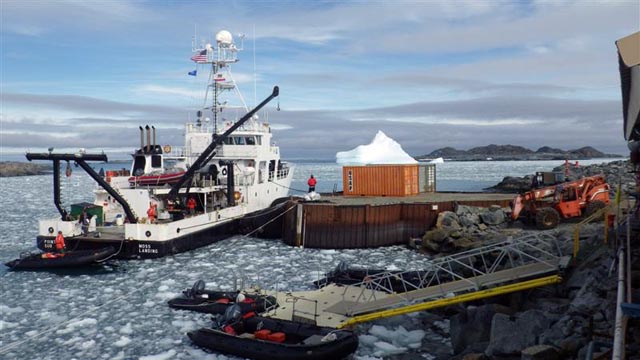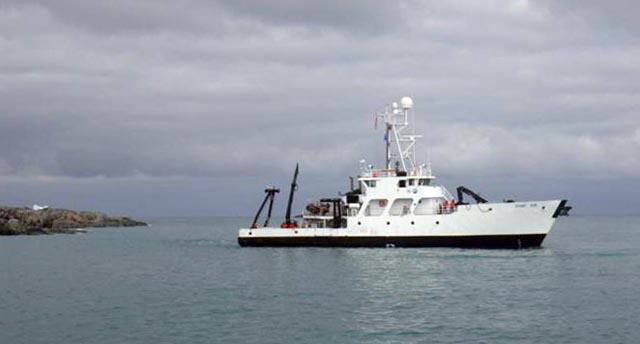|
Taking the pointUNOLS research vessels supports Antarctic researchPosted April 12, 2013
When scientists who come to Palmer Station They could be based on one of the U.S. Antarctic Program’s 
Photo Credit: Sean Bonnette
The research vessels LAURENCE M. GOULD and POINT SUR tie up alongside one another.
If they need to have access to the labs at Palmer Station, the 308-foot-long Palmer would be out of the picture, as it is too large to use the station pier. Another problem with either USAP vessel is that science teams aboard the ships would need to share the time and resources with the other groups that may share space on the same expedition. So, as a trial to improve scientific research along the Antarctic Peninsula, a smaller ship was brought down to see how effective it would be to use. The ship that was chosen to deploy to Palmer Station was the R/V Point Sur Built in 1980, the Point Sur is 135 feet long with a beam of 32 feet and a nine foot draft. She has a gross tonnage of 298 tons. The Gould is more than twice the size, and it is well suited in its role as the primary supply and research vessel that services Palmer Station. However, the Point Sur is capable of more focused science missions, as it can only accommodate up to 11 people. The Point Sur arrived at Palmer near the end of January after several failed attempts to put in a field camp for a team of geologists around the James Ross Island region due to thick sea ice cover. The ship was then used as a science platform in the Palmer area for the next month. She supported researchers with the Palmer Long Term Ecological Research (LTER) The Point Sur allowed scientists based at Palmer with the LTER to collect samples farther away from station in the Palmer Deep, a basin in the relatively shallow continental shelf. Some of the work done from the Point Sur included krill tows, water sampling, and landing field biologists for penguin surveying. The dive team from UAB was able to collect samples in the area near the entrance to the Lemaire Channel, an area unreachable using a Zodiac from Palmer. The group led by Duke University used the Point Sur as a base for tagging and observing whales in the waterways northeast of Palmer. The scientists were able to tag humpback, minke and orca whales in places like Wihelmina Bay, Andvord Bay and the Gerlache Strait. The use of the Point Sur proved to be a success for all the groups who used it as a research platform. It’s hopeful that it or a ship of similar size will continue to be used in the Palmer area in the years to come. |



For USAP Participants |
For The Public |
For Researchers and EducatorsContact UsU.S. National Science FoundationOffice of Polar Programs Geosciences Directorate 2415 Eisenhower Avenue, Suite W7100 Alexandria, VA 22314 Sign up for the NSF Office of Polar Programs newsletter and events. Feedback Form |



